 |
"The Farallon Light
on the Devil's Teeth"
|
|
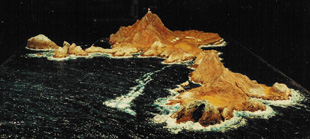 |
|
| |
|
|
2002 -- San Francisco Maritime Museum
Size:
24 in. x 36 in. (2 ft. x 3 ft.)
Scale: 1/8 in. = 20 ft. (1/1920th scale)
Figures: none (scale
is too small - a figure would be about 1/32nd inch tall)
Features: Stunning
water depiction; a unique,
working lighthouse; topography taken from USGS topo map and a range of
historic and contemporary photos and etchings.
|
|
| |
|
| |
|
| The Problem:
The San Francisco Maritime Museum had acquired a new display space in an
historic, 1900 era Fisherman's Wharf warehouse which was undergoing a metamorphosis
to become a classy hotel. The plan included an SFMM display space behind
a partition of glass across one end of the hotel's lobby, desk and lounge
area. The museum's people decided to take this opportunity to display, from
their resources, their original first order Fresnel lens. The lens was from
the first lighthouse ever constructed to protect the Gold Rush era shipping
lanes west of San Francisco from the Farallon Islands. A batch of craggy
mountain peaks rising from the Pacific Ocean, the Farallon Islands were
referred to as "the Devil's Teeth" in the 1850's. As a contrasting
kind of exhibit telling the same story, they decided to go for a diorama
of South Farallon Island, the largest of the batch and the location of that
lighthouse. The notion was to give visitors some idea of what this place
was, and largely still is - a raw and desolate place - but with a predictable,
dependable, and fiercely powerful beacon of security for the seafarers 25
miles west of San Francisco. |
|
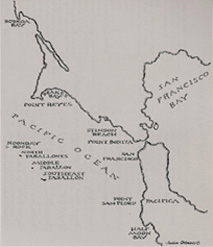
Location map of the Farallon Islands in relation to San Francisco Bay*
|
|
|
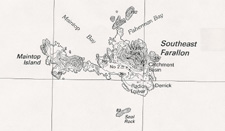
This is the USGS topological (topo) map which was translated into the
diorama's island(s).
|
|
|
|
|

This photo is from the south-south-east and corresponds with the topo
map above pretty well.
|
|
|
|
|
|
| |
|
|
|
|
| |
|
|
|
|
|
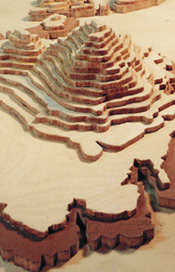
The topo map contour lines were applied to each 20 ft. layer.
|
|
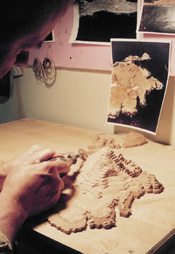
Aerial photos were used to help shape the layers. |
|
|
|
|
| |
|
|
|
|
| The Challenge:
Determine a scale that would be large enough to include recognizable details
of man's presence upon the island, but small enough to present the entire
island surrounded by the mighty Pacific Ocean, and still fit on a two foot
by three foot base. In addition, while the eastern half of the Island had
been documented extensively since the 1860's in photos and etchings, the
West End (as it is called) has not. |
|
|
|
|
| |
|
|
|
|
|
| |
The series of diorama
images below are arranged to represent what you might see from an aircraft
making a slow pass around the island. |
|
|
|
|

Approaching from the west at about 300 ft. The Great Arch (over 100 ft.high)
addorns the West End of Maintop.
|
|
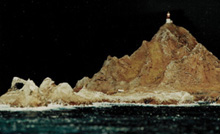
Crossing Maintop Bay, the craft drops to 200 ft. The lighthouse flares;
Arch Rock is at the left. |
|
|
|
| |
|
|
|
|
The Solution: While
we normally make a sight visit to any geographic area we intend to model,
the Farallons are 25 miles at sea and a National bird sanctuary with difficult
access - both legally and physically. Such a visit was, therefore, not
an option. All our understanding came from images (historic and contemporary
photos, etchings, etc.) from SFMM, libraries, and the Internet. The determination
of the appropriate scale resulted in the smallest scale we had ever worked
in, and required us to develop a different approach. We modeled in a scale
so small that the little structures were less than half the size of "Monopoly"
game houses. As we labored to understand the shape of the West End through
interpretation of the USGS topo maps, it began to appear that there was
a 100 + foot high - arch at the far west end, but no one had an image.
We finally found the corroborating images so the West End could be shaped
according to the layers described by the to-PO map, and finally "tuned"
according to the dozen or more photos we had selected as illustrating
our primary surface flavors. As we developed details for the super-small
scale, we happened upon a product for hobby-miniaturists that was intended
for modeling a much larger scale lighthouse, but included a little printed
circuit board, a small DC bulb and a transformer. We reconfigured the
system to use a "AA" battery pack to eliminate the need for
a wall plug. We then converted to a smaller - 1/8th inch dia.- DC bulb
which we painted and glued on a base collar and a funnel- shaped cap to
represent the lighthouse itself. The result is a lighthouse with
a 9 second cycle, taking a half-second to ramp-up to its brightest light,
which it holds for about a second, then ramps back to 'off'', simulating
the sweep of the lighthouse beam. The effect is amazing! Martha's water
is once again visably true, and Joanne's earth tones and organic scrubby
ground cover read very well.
|
|
|
|
| |
|
|
|
|
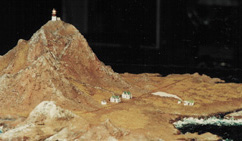
Turning south and climbing back past 300 ft., the terrace and keeper's houses
appear on the left. |
|
|
|
|
|
|
|
|
|
|
|
|
|
|
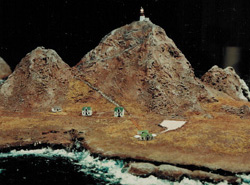
The lighthouse keeper's houses all face south, as do the steam-powered fog
horns. |
|
|
| |
|
|
|
|
|
|
|
|
| |
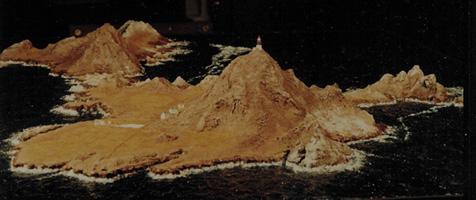
Reaching 450 ft. and turning north, the Great Murre Cave is now visible.
Farther around the north side of the island Fisherman's Bay can be seen,
and once again, Arch Rock.
|
|
|
|
|
|
| |
|
|
|
|
|
| |
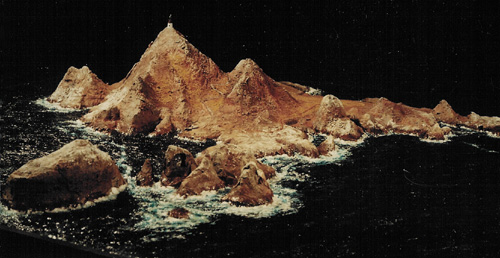
Finishing the pass around the north side of the island provides a view of
Sugar Loaf Rock and its white frosting of bird droppings. Before its removal
in 1969, the light flared exactly every minute so ships at sea could
identify that it was the Farallon light and know their exact position.
|
|
|
|
| |
|
|
|
|
|
|

Turning south across the Jordan Channel that separates the two segments
of the island, the light flares a farewell. |
|
|
|
|
|
|
|
| |
|
|
|
|
|
|
|
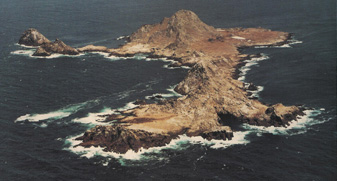
Photo of "the real McCoy"...*
|
|
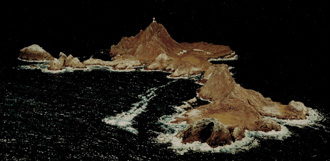
... compared to the diorama (above). |
|
|
|
|
|
|
|
| |
|
|
|
|
|
|
| |
|
|
|
|
|
|
|
*images from "The Farallon Islands - Sentinel
of The Golden Gate" by Peter White
|
|
|
|
|
|
|
|
|
|
Website designed by Moments In Time Exhibits
Contact webmaster
with comments/questions.
|
|
|
|
|
|
|
|
|
|
|
|
|
|
|
|
|
|
|
|
|
|
|
|
|
|
|
|
|
|
|

